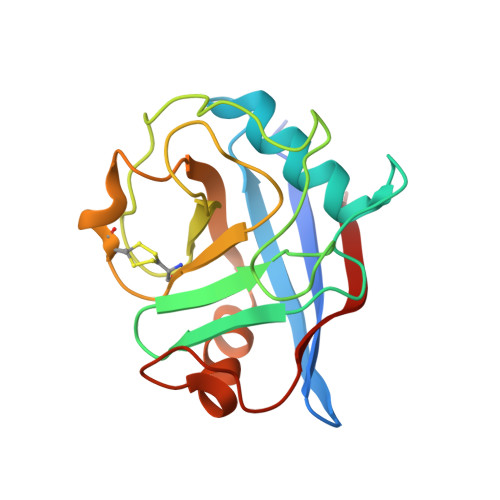The Three-Dimensional Structure of Two Redox States of Cyclophilin-A from Schistosoma Mansoni: Evidence for Redox- Regulation of Peptidyl-Prolyl Cis-Trans Isomerase Activity.
Gourlay, L.J., Angelucci, F., Baiocco, P., Boumis, G., Brunori, M., Bellelli, A., Miele, A.E.(2007) J Biol Chem 282: 24851
- PubMed: 17591771
- DOI: https://doi.org/10.1074/jbc.M702714200
- Primary Citation of Related Structures:
2CK1, 2CMT - PubMed Abstract:
Treatment of schistosomiasis, a widespread human parasitic disease caused by the helminth parasites of the genus Schistosoma, relies mainly on one chemotherapeutic agent, praziquantel, although several other compounds exert anti-parasitic effects. One such compound is the immunosuppressant cyclosporin A, which has been shown to significantly diminish worm burden in mice infected with Schistosoma mansoni. Given the well established interaction between cyclosporin A and the cyclophilin superfamily of peptidylprolyl cis-trans isomerases, we solved the structure of cyclophilin A from S. mansoni (SmCypA) by x-ray crystallography in the reduced and oxidized states at 1.5 and 1.8 A of resolution, respectively. Oxidized SmCypA contains a disulfide bridge between two C-terminal cysteines (Cys-122 and Cys-126). This is the first example of a cyclophilin containing this disulfide bridge. Parallel functional studies suggest a mechanism for regulation of SmCypA activity via oxidation of its thiol groups; in fact, whereas oxidized SmCypA is inactive, reduced SmCypA is an efficient isomerase active at nanomolar levels with a k(cat)/K(m) of 1.1 x 10(7) M(-1) s(-1), and it is inhibited by cyclosporin A (IC(50) of 14 +/- 4 nM). The lack of conservation of this cysteine couple within the CypA superfamily, their close proximity to the active site, and the importance of thiol groups for peptidyl-prolyl cis-trans isomerase activity render this structural feature a challenge for the development of alternative and more effective anti-schistosomiasis inhibitors and may in addition imply an alternative function of SmCypA in the schistosome.
Organizational Affiliation:
Istituto Pasteur-Fondazione Cenci Bolognetti, Department of Biochemical Sciences "A. Rossi Fanelli," "Sapienza" University of Rome, Piazzale Aldo Moro 5, 00185 Rome, Italy.















